Make my authentic Shrimp Yakisoba recipe with savory homemade sauce in under 30 minutes. I’ll teach you how to sear the seafood and char the crisp veggies to achieve the signature street-food flavor of these Japanese stir-fried noodles at home.

Classic Yakisoba typically calls for sliced pork belly, but I love seafood in these Japanese stir-fried noodles, too. Today, I’m bringing you Shrimp Yakisoba loaded with juicy shrimp, tasty calamari, and crisp vegetables. It’s a satisfying dish that comes together quickly on a busy weeknight. You’ll be glad you skipped takeout!
Hungry for more Japanese noodle dishes? Try my Yaki Udon, Vegetable Yakisoba, and Sara Udon recipes next!
What is Yakisoba?
Yakisoba (焼きそば) literally means “fried noodles” in Japanese and is one of Japan’s best-known noodle dishes. It’s Chinese-style wheat noodles that are pan-grilled with meat or seafood and crisp vegetables and seasoned with a signature sweet-savory sauce. While this iconic street food is synonymous with Japanese festival (matsuri) food, you can also find it served at specialty okonomiyaki restaurants, school and sporting events, and fairs.
Table of Contents
Why I Love This Recipe
- Delicious stir-fried noodles with minimal effort. Using shrimp and calamari as the main proteins means this yakisoba is ready in a flash! I love that you only need to thaw the frozen seafood and they’re ready to go.
- It’s big on smoky, savory, and umami flavor! My homemade yakisoba sauce adds authentic umami. I’ll also show you how to achieve a mouthwatering char on the ingredients for a major flavor boost.
- This one-pan weeknight meal will transport you to Japan! A sizzling hot plate of homemade yakisoba brings to the table an authentic taste of Japan—plus nostalgic memories of enjoying these delicious noodles when I was growing up.

Ingredients for Shrimp Yakisoba
- Yakisoba noodles
- Squid – I used defrosted calamari steak
- Shrimp
- Sake – to quick-marinate the seafood
- Green cabbage
- Onion
- Green onions/scallions
- Carrot
- Neutral oil – for cooking
- Freshly ground black pepper
- Yakisoba sauce:
- Worcestershire sauce
- Oyster sauce
- Ketchup
- Soy sauce
- Sugar
Find the printable recipe with measurements below.
Jump to RecipeSubstitutions
- Shrimp and squid – I stock my freezer with frozen seafood so I’m ready to put together this shrimp yakisoba without making a special trip to the market. For maximum convenience, I recommend using frozen shrimp and frozen calamari steak for this recipe. Simply thaw them overnight in the fridge (or flash defrost) and they’re ready to use.
- Yakisoba sauce – I share my homemade yakisoba sauce in this recipe that is so quick and easy to whip together. With just 5 pantry ingredients, it takes just a couple of minutes to make from scratch! If you don’t have these condiments at home, you can use bottled sauce from the store. Otafuku brand offers a yakisoba sauce that’s very popular in Japan.
- Yakisoba noodles – For yakisoba, we use mushi chukamen (蒸し中華麺), which are Chinese-style noodles made with wheat flour. I recommend using yakisoba noodles that you can find in the refrigerator section of Japanese and Asian supermarkets. These pre-steamed and greased noodles are not egg noodles, even though they have a yellowish color. While they share a texture that’s similar to ramen noodles, they are not the same. Therefore, please do not substitute ramen or buckwheat soba noodles in this recipe. In a pinch, you can use fresh Chinese stir-fried noodles from Asian grocery stores. Please avoid using frozen noodles or any type because they tend to break into pieces when defrosted.
Key Equipment
- Griddle, large wok, or large skillet with a big cooking surface
- Tongs or two spatulas
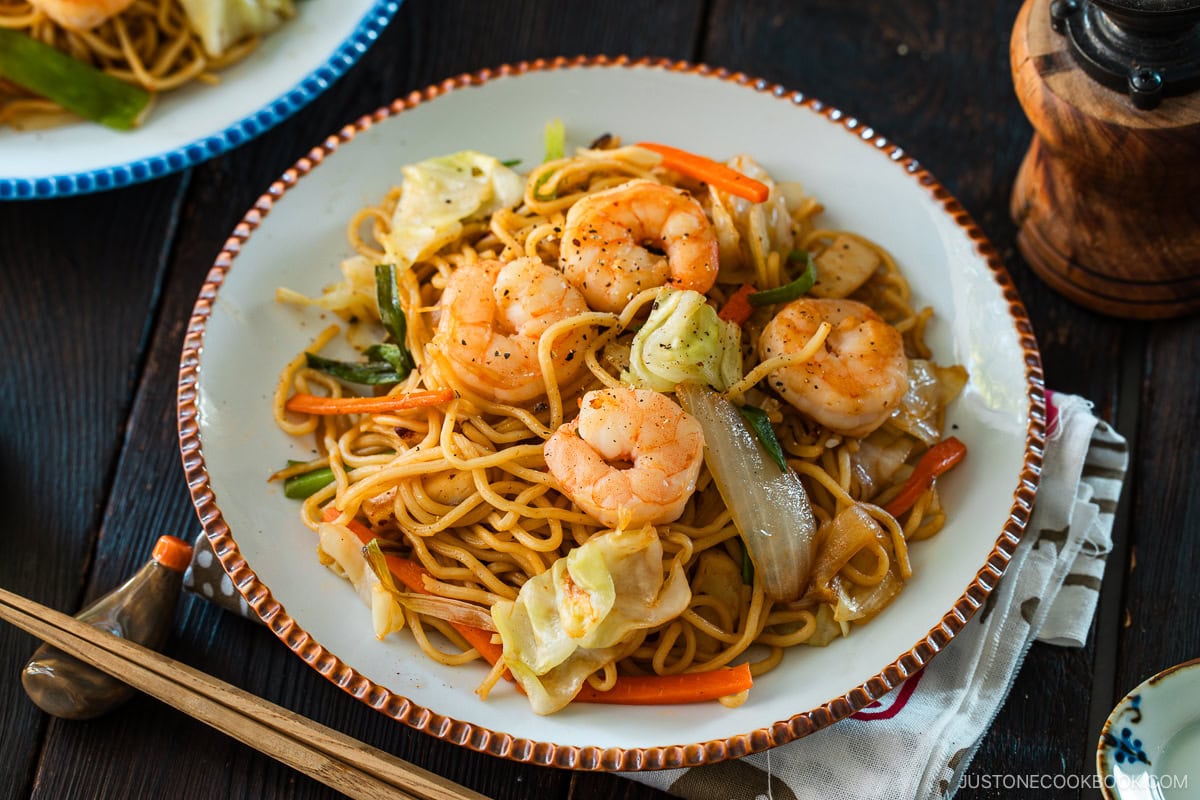
How to Make Shrimp Yakisoba
Preparation
Step 1 – Make the sauce. Combine the Worcestershire sauce, oyster sauce, ketchup, soy sauce, and sugar in a small bowl. Whisk until the sugar is dissolved.
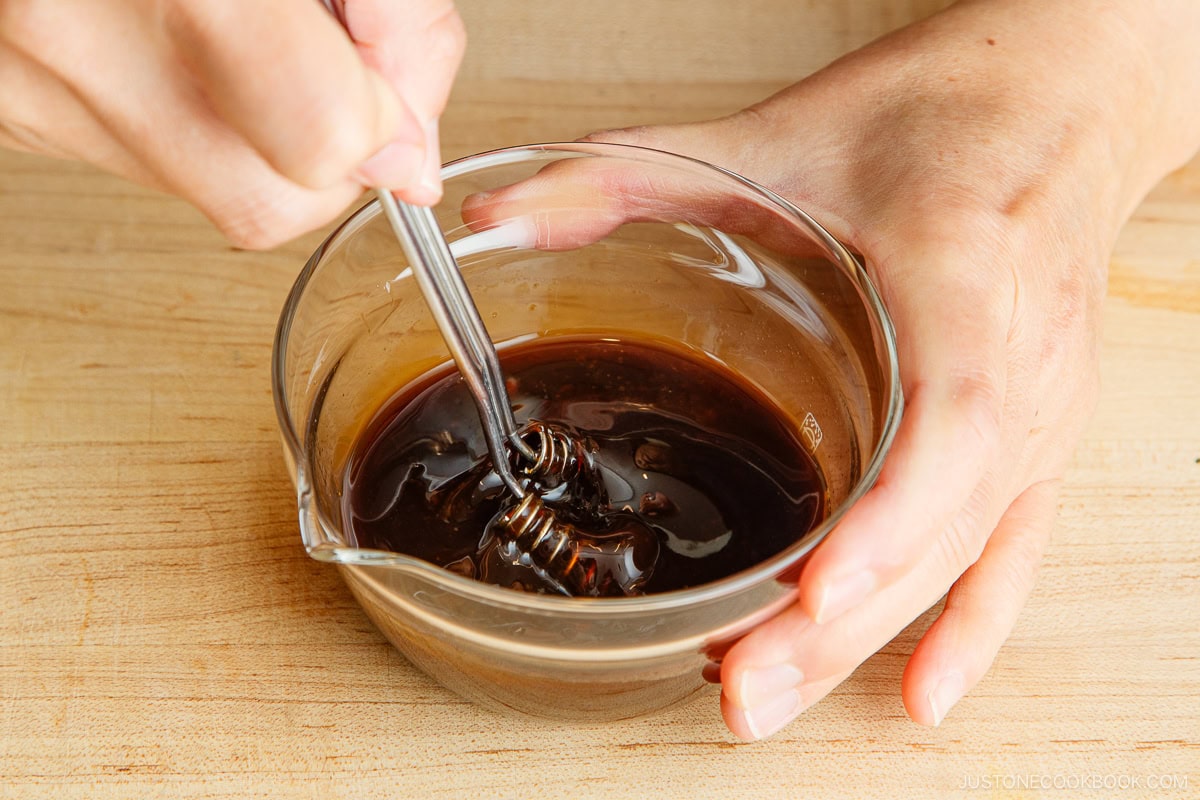
Step 2 – Marinate the seafood and chop the vegetables. Peel the shrimp and cut the squid into bite-size strips. Toss the seafood with the sake to marinate. Cut the onion, carrot, green onion/scallion, and cabbage into bite-size pieces.

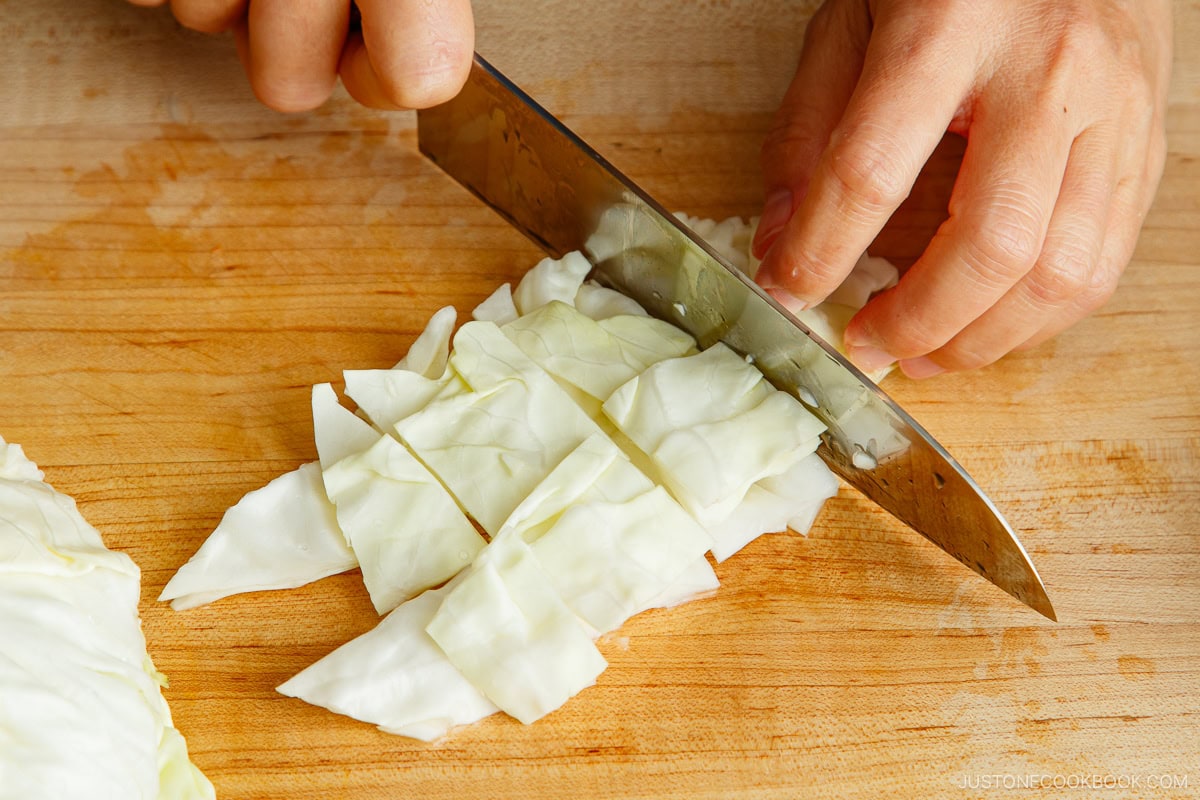
Step 3 – Loosen the yakisoba noodles. Place the pre-steamed yakisoba noodles on a plate and cover with a damp paper towel. Heat in the microwave to steam, then loosen the noodles with your hands.


Cooking
Step 4 – Start cooking the onions and sear the seafood. On a griddle, sauté the onions and white part of the green onions in the hot oil. Push them to one side and add the shrimp and squid to sear quickly. Remove the seafood to a tray.


Step 5 – Sauté the vegetables in succession and add the cooked seafood. To the cooking onions, add the carrot and cabbage and toss together. Let the veggies develop a nice char, stirring occasionally. Once they’re crisp-tender, add the cooked seafood and the green part of the scallions. Toss quickly to combine.

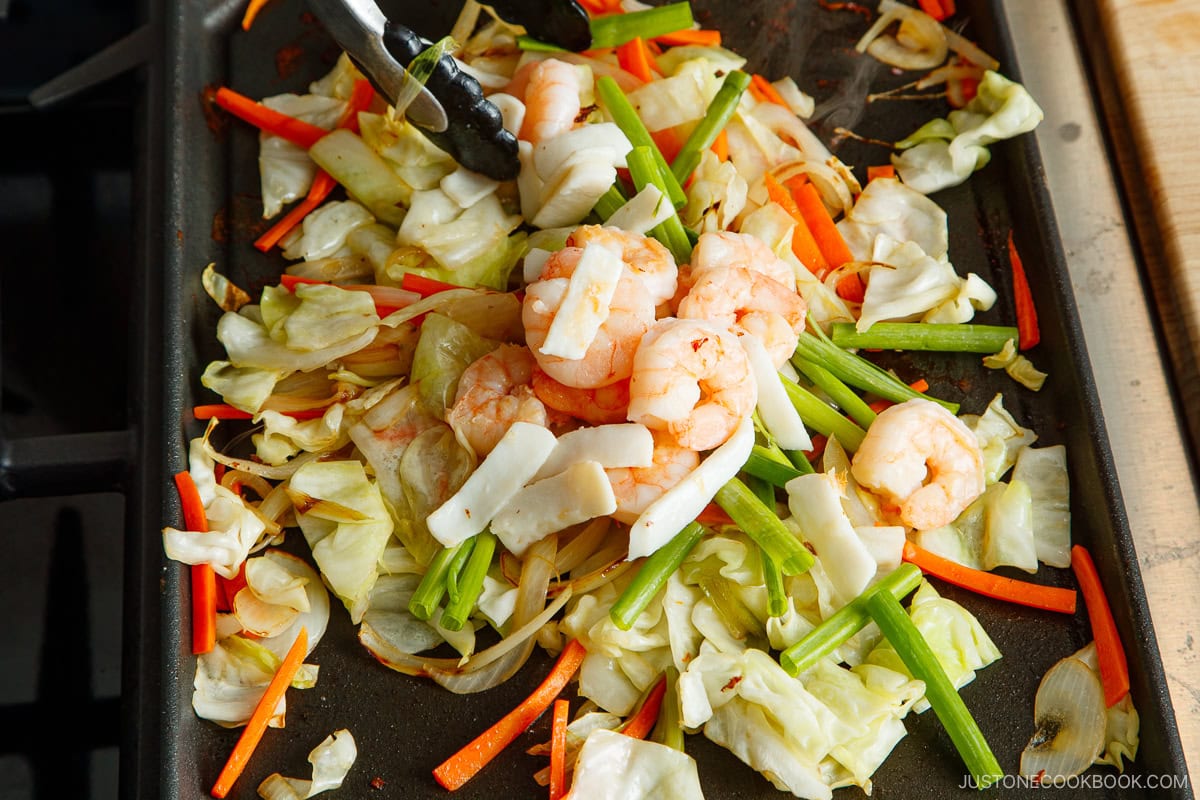
Step 6 – Add the loosened noodles and sauce. Spread out the veggies on the cooking surface and place the noodles across the top. Pour the sauce on the noodles, then toss to combine evenly.


Step 7 – Serve! Serve immediately on individual plates, season with ground black pepper, and sprinkle with your favorite optional toppings. Enjoy!

Nami’s Recipe Tips
- Use a large cooking surface – It’s important to use a griddle, wok, or frying pan with a large cooking space so that your ingredients have direct contact with the hot surface. The nice char will add fantastic flavor and give the noodles a “street food” character. I highly recommend using a griddle at home to make yakisoba as well as Okonomiyaki and all sorts of pancakes!
- Sear the seafood first, then remove from the griddle – Quickly sear the shrimp and calamari until just cooked, then transfer it to a plate while you cook the vegetables. This will ensure that they cook properly but don’t overcook while you’re stir-frying the veggies.
- Cook the veggies in stages – To retain the fresh texture and crunch of each vegetable, start cooking the hard veggies first before adding the softer ingredients. Each vegetable has a different cooking time, so cook them in succession. Do not throw in everything at once or you risk overcooking the soft veggies. Wilted veggies are a no-no for stir-fries.
- Loosen up the noodles first – I recommend loosening the noodles quickly before mixing with the stir-fried ingredients. Here, I heat them with a little steam in the microwave and separate them with my fingers. If you don’t loosen them, they will most likely break into small pieces on the griddle or wok.
- Don’t add too many ingredients – I know that it’s tempting to toss in lots of veggies or extra protein. But adding too many ingredients will end up steaming the noodles instead of frying them. You need to let the steam escape so the noodles are not wet. This helps make the noodles dry or a little crispy for the perfect texture.
- Make double the sauce – My homemade recipe below is the exact amount you’ll need for the yakisoba ingredients that I list. If you add more ingredients or like it strongly seasoned, I recommend doubling the sauce. That way, you can adjust the seasoning to your liking. You don’t want the noodles to be bland.
Variations and Customizations
This dish is so versatile and you can change it up with your favorite ingredients or what you have on hand. Here are some delicious ideas to try.
- Use other proteins. To switch out or supplement the shrimp and squid, you could also use scallops or sliced pork belly. My mom often changes up the proteins in her classic yakisoba, sometimes adding Japanese sausage or ground pork to the pork belly slices. My favorite combination is ground pork and squid/calamari! While chicken is not a common yakisoba ingredient in Japan, chicken thighs work well. Here’s my Easy Chicken Yakisoba recipe.
- Add your favorite vegetables. I encourage you to try other veggies that work well in stir-fries. I regularly change things up with my favorite produce like sliced shiitake mushrooms, bean sprouts, garlic chives (nira), sweet bell pepper strips, and sliced baby bok choy. Snow peas, asparagus, broccoli, komatsuna, and corn kernels also work in this dish. Remember to cook them in succession so they stay crisp-tender.
- Use optional toppings. I love adding traditional yakisoba toppings like aonori (powdered green seaweed) and beni shoga (red pickled ginger) when plating this dish. Some people also like to top it with katsuobushi (shaved bonito flakes).
- Make it vegan/vegetarian. You can swap the seafood for deep-fried firm tofu cutlet (atsuage) or baked tofu. Instead of standard oyster sauce, I recommend using Lee Kum Kee Vegetarian Stir-Fry Sauce. Vegan Worcestershire sauce is also available.
What to Serve with Shrimp Yakisoba
With a balance of proteins and veggies, Shrimp Yakisoba is a complete one-plate meal on its own. I also like to serve it as a side dish along with other dishes to balance and complete the meal:
- With fried dumplings – Try serving it with my easy Chicken Shiso Gyoza with Yuzu Kosho & Ponzu Sauce
- With a side salad – I love the refreshing contrast of this Japanese Cucumber Salad (Sunomono).
- With fried chicken – Karaage (Japanese Fried Chicken) is a scrumptious way to add protein to the meal
- With soup – I pull the meal together with my comforting Homemade Miso Soup.
- In a sandwich – I adore these noodles stuffed in a sandwich roll in a dish called Yakisoba Pan!

Storage and Reheating Tips
To store: Any leftovers can be stored in an airtight container in the refrigerator for up to 3 days. However, if you used previously frozen shrimp or calamari to make this recipe, I don’t recommend freezing the leftovers.
To reheat: Heat the leftovers in the microwave until warmed through.
Frequently Asked Questions
In Japan, chicken or beef is not a common protein choice for yakisoba, but you can certainly use it. I recommend chicken thighs rather than breasts because thighs are more flavorful and don’t get dry easily.
In general, I recommend that you avoid tender leafy greens like spinach with a high-moisture content. They’re not ideal for stir-fries, which require a dry pan to create a nice char and crispy pan-grilled texture. Soft salad-type greens also wilt very easily, which is a no-no for stir-fries like yakisoba.
You can, but make sure that you don’t overcrowd the griddle, wok, or other large cooking surface. If you do, you will end up steaming the ingredients instead of pan-grilling them, and you won’t develop that signature charred flavor of yakisoba. To double the recipe, I suggest using a second griddle and cooking two batches at the same time.
More Yakisoba Recipes
If you love this Shrimp Yakisoba, you’re in for a treat with these other irresistible yakisoba recipes.
- Hiroshima-Style Okonomiyaki (yakisoba topped with okonomiyaki that we call “modern-yaki” in Japan!)
- Yakisoba with Malony Glass Noodles (gluten-free)



Shrimp Yakisoba
Ingredients
- 5 oz shrimp (roughly 10 pieces, but it depends on the size of the shrimp)
- 2 oz squid (I used frozen and defrosted calamari steak)
- 2 Tbsp sake (to marinate the seafood)
- ½ lb green cabbage (about ¼ small head)
- ½ onion (5 oz, 142 g)
- 3 green onions/scallions
- 4 inches carrot (3.5 oz, 100 g)
- 3 servings yakisoba noodles (pre-steamed; one package contains 3 servings, 16–17 oz, 454–480 g)
- 1 Tbsp neutral oil (plus more, if needed)
- freshly ground black pepper (to taste)
For the Yakisoba Sauce
- 3 Tbsp Worcestershire sauce (use vegan Worcestershire sauce for vegan)
- 4 tsp oyster sauce (use Lee Kum Kee Vegetarian Stir-Fry Sauce for shellfish allergies or vegetarian)
- 3 tsp ketchup
- 2 tsp soy sauce
- 2 tsp sugar (plus more, to taste)
For the Toppings (optional)
Instructions
- Gather all the ingredients. Tip: For the sauce, I recommend doubling the recipe, just in case you need extra. If you end up adding more ingredients, you‘ll need more sauce so the yakisoba noodles are flavorful.

To Make the Yakisoba Sauce
- Whisk together the sauce ingredients: 3 Tbsp Worcestershire sauce, 4 tsp oyster sauce, 3 tsp ketchup, 2 tsp soy sauce, and 2 tsp sugar until the sugar is completely dissolved. Tip: It‘s important to taste the sauce now and add more sugar, if needed. For example, some ketchup is sweeter than others while some Worcestershire sauce is less sour than others. Set it aside.

To Prepare the Ingredients
- Peel and devein 5 oz shrimp. Cut 2 oz squid into bite-size strips. Place the seafood in a bowl and toss with 2 Tbsp sake to marinate. Set aside to marinate.

- Cut ½ onion into ¼-inch (6-mm) slices.

- Cut 4 inches carrot into 2-inch slabs. Then, cut them into julienne strips 2 inches (5 cm) long.

- Remove the tough core from ½ lb green cabbage. Cut the cabbage leaves into slices 1 inch (2.5 cm) wide. Then, cut the slices into bite-sized pieces.

- Chop 3 green onions/scallions into 2-inch (5-cm) pieces. Cut any thick, white parts of the green onions in half lengthwise. Keep the green and white parts in separate piles.

- Place the 3 servings yakisoba noodles on a plate and cover with a damp paper towel. Heat in the microwave to steam, then loosen the noodles with your hands.
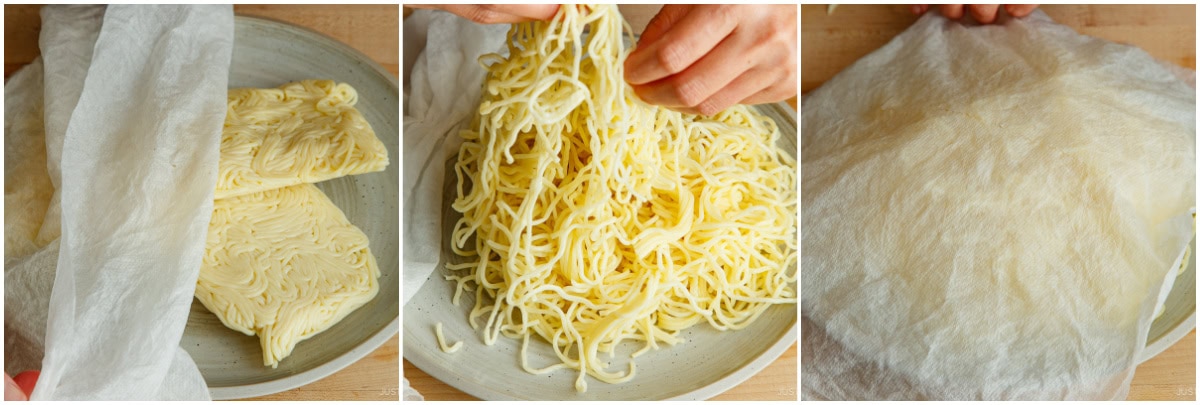
To Cook the Shrimp Yakisoba
- Heat a griddle, large wok, or large skillet on medium-high heat, then add 1 Tbsp neutral oil. When the oil is hot, add the sliced onions and white part of scallions. Sauté, tossing occasionally with a pair of tongs, allowing the onions to char on the edges and soften a bit. When they start to become translucent, push them one the side of the griddle. Add the shrimp in a single layer to an empty space on the cooking surface.

- Add the squid pieces next to the shrimp in a single layer. Quickly sear the seafood, flipping the shrimp when it turns opaque and pan-grilling the squid until its juices evaporate on the griddle. Remove the seafood to a tray.

- Add the cabbage and carrot to the cooking onions and toss together. Cook the vegetables while tossing occasionally, leaving them to grill and brown on the hot cooking surface and develop a golden char. When the cabbage is slightly softened but still crisp, spread out the vegetables across the griddle. Add the cooked seafood and green part of the scallions across the top.

- Spread out the loosened noodles across the top of the vegetables and seafood. Then, pour the yakisoba sauce on top of the noodles.

- Toss to combine the noodles, seafood, and vegetables and distribute the sauce evenly. Lower the heat, if needed. Taste and add more sauce, if desired. Toss and turn off the heat.

To Serve
- Transfer the shrimp yakisoba to individual plates. Sprinkle with freshly ground black pepper to taste and top with optional aonori (dried green laver seaweed) and pickled red ginger (beni shoga or kizami beni shoga). Enjoy!
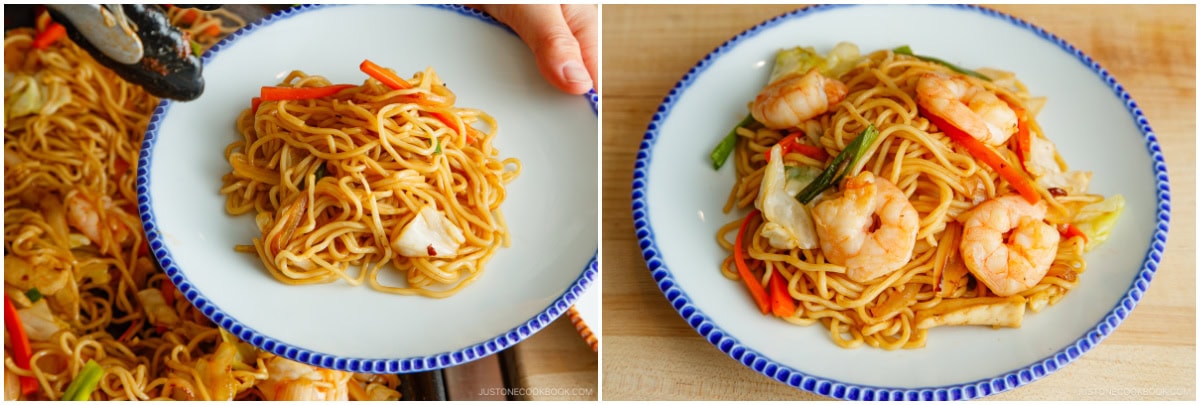
To Store
- You can store the leftovers in an airtight container in the refrigerator for up to 3 days. If you used previously frozen shrimp or calamari to make this recipe, I don’t recommend freezing the leftovers. Reheat in the microwave until warmed through. If you have any leftover homemade yakisoba sauce, you can store it in a mason jar or other airtight container for up to a month.
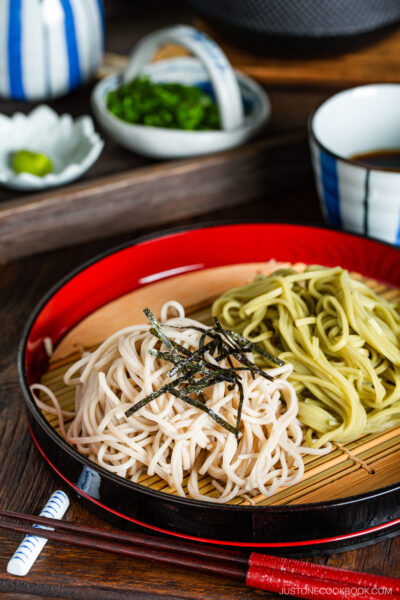
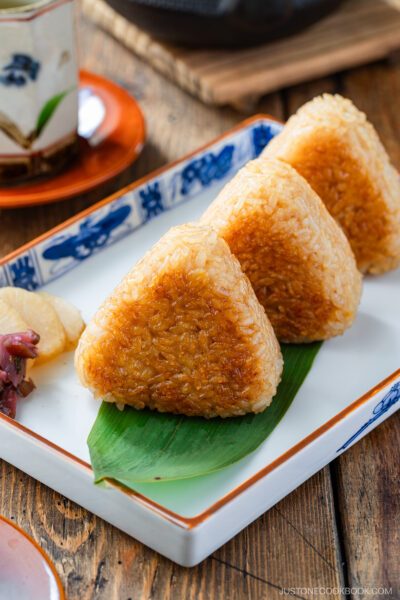






If you are thinking of making this recipe…DO IT! The flavor takes me right back to Japan. Thank you for sharing in making my day a lot better. The sauce is perfection!
Hello, Melissa! Thank you for trying Nami’s recipe and for your encouragement!
We are happy to hear you enjoyed the dish! 🥰
I made this last week 2X’s and it was delicious and very easy. I had trouble finding squid, that was not already breaded, and finally found a package of whole squid that was frozen. Since they were small, it was easier to cut the bodies so ended up with the tubular circles. Oh, everything was so delicious and I’m glad I doubled the sauce. I need to invest in some udon bowls, as the noodles quickly cooled so we heated in the microwave.
Hello Randy! Thank you for trying Nami’s recipe and sharing your Shrimp Yakisoba photo! It looks delicious!
We are happy to hear you enjoyed the recipe. Happy Cooking!
Is this still yakisoba if I make it with Hakubaku dry udon noodles? I ask because my doctors have me watching my sodium intake and with any of the refrigerated or frozen yakisoba noodles I’ve been able to find it’s through the roof. Tastes great even this way, I’m really just curious if it’s the same thing.
Hi, Jack! Thank you for trying Nami’s recipe.
If you use udon noodles, we usually call the dish Shrimp Yakiudon.😃 We hope this helps!
I don’t use a microwave because I believe it’s unhealthy. How do you suggest that I warm the noodles. Many thanks, J
Hi, Janis! Thank you for trying Nami’s recipe.
You may reheat them in a large skillet over medium heat. If the dish has dried out, add about two tablespoons of water.
We hope this helped!
Can you use dry udon noodles for the yakisoba recipe? All of the frozen or refrigerated yakisoba noodles I can find have WAY too much sodium for me.
Thanks,
Jack
Hello, Jack. Thank you for trying Nami’s recipe.
Yes. The texture will be altered, but you can use it. Happy cooking!